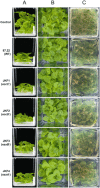The ESX/type VII secretion system modulates development, but not virulence, of the plant pathogen Streptomyces scabies
- PMID: 23009676
- PMCID: PMC6638804
- DOI: 10.1111/j.1364-3703.2012.00835.x
The ESX/type VII secretion system modulates development, but not virulence, of the plant pathogen Streptomyces scabies
Abstract
Streptomyces scabies is a model organism for the investigation of plant-microbe interactions in Gram-positive bacteria. Here, we investigate the type VII protein secretion system (T7SS) in S. scabies; the T7SS is required for the virulence of other Gram-positive bacteria, including Mycobacterium tuberculosis and Staphylococcus aureus. The hallmarks of a functional T7SS are an EccC protein that forms an essential component of the secretion apparatus and two small, sequence-related substrate proteins, EsxA and EsxB. A putative transmembrane protein, EccD, may also be associated with T7S in Actinobacteria. In this study, we constructed strains of the plant pathogen S. scabies carrying marked mutations in genes coding for EccC, EccD, EsxA and EsxB. Unexpectedly, we showed that all four mutant strains retain full virulence towards several plant hosts. However, disruption of the esxA or esxB, but not eccC or eccD, genes affects S. scabies development, including a delay in sporulation, abnormal spore chains and resistance to lysis by the Streptomyces-specific phage ϕC31. We further showed that these phenotypes are specific to the loss of the T7SS substrate proteins EsxA and EsxB, and are not observed when components of the T7SS secretion machinery are lacking. Taken together, these results imply an unexpected intracellular role for EsxA and EsxB.
© 2012 THE AUTHORS. MOLECULAR PLANT PATHOLOGY © 2012 BSPP AND BLACKWELL PUBLISHING LTD.
Figures







Similar articles
-
Secretion of atypical protein substrates by the ESAT-6 secretion system of Staphylococcus aureus.Mol Microbiol. 2013 Nov;90(4):734-43. doi: 10.1111/mmi.12395. Epub 2013 Oct 4. Mol Microbiol. 2013. PMID: 24033479 Free PMC article.
-
The ESX-1 Substrate PPE68 Has a Key Function in ESX-1-Mediated Secretion in Mycobacterium marinum.mBio. 2022 Dec 20;13(6):e0281922. doi: 10.1128/mbio.02819-22. Epub 2022 Nov 21. mBio. 2022. PMID: 36409073 Free PMC article.
-
Esx Paralogs Are Functionally Equivalent to ESX-1 Proteins but Are Dispensable for Virulence in Mycobacterium marinum.J Bacteriol. 2018 May 9;200(11):e00726-17. doi: 10.1128/JB.00726-17. Print 2018 Jun 1. J Bacteriol. 2018. PMID: 29555701 Free PMC article.
-
Genetic and physiological determinants of Streptomyces scabies pathogenicity.Mol Plant Pathol. 2009 Sep;10(5):579-85. doi: 10.1111/j.1364-3703.2009.00561.x. Mol Plant Pathol. 2009. PMID: 19694949 Free PMC article. Review.
-
Targeting type VII/ESX secretion systems for development of novel antimycobacterial drugs.Curr Pharm Des. 2014;20(27):4346-56. doi: 10.2174/1381612819666131118170717. Curr Pharm Des. 2014. PMID: 24245757 Review.
Cited by
-
High levels of DegU-P activate an Esat-6-like secretion system in Bacillus subtilis.PLoS One. 2013 Jul 4;8(7):e67840. doi: 10.1371/journal.pone.0067840. Print 2013. PLoS One. 2013. PMID: 23861817 Free PMC article.
-
Homeostasis of N-α-terminal acetylation of EsxA correlates with virulence in Mycobacterium marinum.Infect Immun. 2014 Nov;82(11):4572-86. doi: 10.1128/IAI.02153-14. Epub 2014 Aug 18. Infect Immun. 2014. PMID: 25135684 Free PMC article.
-
WhiB6 regulation of ESX-1 gene expression is controlled by a negative feedback loop in Mycobacterium marinum.Proc Natl Acad Sci U S A. 2017 Dec 12;114(50):E10772-E10781. doi: 10.1073/pnas.1710167114. Epub 2017 Nov 27. Proc Natl Acad Sci U S A. 2017. PMID: 29180415 Free PMC article.
-
The exceptional form and function of the giant bacterium Ca. Epulopiscium viviparus revolves around its sodium motive force.Proc Natl Acad Sci U S A. 2023 Dec 26;120(52):e2306160120. doi: 10.1073/pnas.2306160120. Epub 2023 Dec 18. Proc Natl Acad Sci U S A. 2023. PMID: 38109545 Free PMC article.
-
Comparative genomics reveals insight into the phylogeny and habitat adaptation of novel Amycolatopsis species, an endophytic actinomycete associated with scab lesions on potato tubers.Front Plant Sci. 2024 Mar 27;15:1346574. doi: 10.3389/fpls.2024.1346574. eCollection 2024. Front Plant Sci. 2024. PMID: 38601305 Free PMC article.
References
-
- Akpe San Roman, S. , Facey, P.D. , Fernandez‐Martinez, L. , Rodriguez, C. , Vallin, C. , Del Sol, R. and Dyson, P. (2010) A heterodimer of EsxA and EsxB is involved in sporulation and is secreted by a type VII secretion system in Streptomyces coelicolor . Microbiology, 156, 1719–1729. - PubMed
-
- Bignell, D.R. , Seipke, R.F. , Huguet‐Tapia, J.C. , Chambers, A.H. , Parry, R.J. and Loria, R. (2010) Streptomyces scabies 87‐22 contains a coronafacic acid‐like biosynthetic cluster that contributes to plant–microbe interactions. Mol. Plant–Microbe Interact. 23, 161–175. - PubMed
-
- Bitter, W. , Houben, E.N. , Bottai, D. , Brodin, P. , Brown, E.J. , Cox, J.S. , Derbyshire, K. , Fortune, S.M. , Gao, L.Y. , Liu, J. , Gey van Pittius, N.C. , Pym, A.S. , Rubin, E.J. , Sherman, D.R. , Cole, S.T. and Brosch, R. (2009) Systematic genetic nomenclature for type VII secretion systems. PLoS Pathog. 5, e1000507. - PMC - PubMed
Publication types
MeSH terms
Substances
Grants and funding
LinkOut - more resources
Full Text Sources

